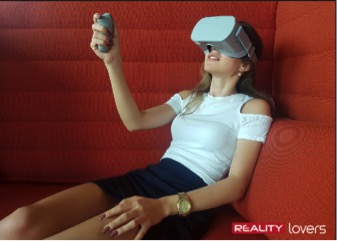Oculus Go – The Great VR Enabler
By Imrich Munka
Head of Product, Reality Lovers
The makers of Oculus Go call it the most approachable VR product on the market. We at Reality Lovers think this may actually be a fitting description in that for many VR novices — and even not-so-novices — this new kid on the block could be the perfect entry point into the ever expanding world of virtual reality. Sporting a unique combination of features packed into one neat unit, with agreeable price tag, it is bound to give the competition a run for their money.
First Impressions First
We were on a mission to put our new toy through its paces by playing one of our latest videos in 4K, the highest resolution the GO supports.
Perhaps the main difference we noticed immediately is that The Go has killed the smartphone. In other devices, you would typically insert a mobile device into the front of the unit. The Go’s answer is to pack everything you need to run VR neatly into the headset itself. The Go’s brilliant smartphone-less design was only matched by its flawless Wi-Fi connectivity feature. We could not be happier.
From the moment you unbox this puppy, it sure feels like a high-end product. For a moment, we thought we robbed a bank and got away with it.
This is one comfortable headset that comes with plenty of plush padding (as was claimed, the result of cooperation with the garment industry). Although at first it may seem like there is a slight weight distribution imbalance toward the front, don’t panic – in the event of an emergency, there is a sturdy strap down the middle to hold it in place.
If we wanted to be real nitpickers (guilty), we would comment that there was a bit of light seeping in through the bottom. But this didn’t bother us too much, as we were sucked into what was happening on the screen.
VR Running In No Time
Setting up the Go was easy and simple, and it took only about five minutes of our eventful lives. And yes, we had to reach for our smartphone, but only once. See, the Go does requires a phone, but only for this initiation ritual. Once the software is loaded, you can use it for other things, like texting people about your new toy.
You can cut out the middle man (mobile device). Instead, the device’s built in Wi-Fi allowed us to stream or download content directly into its belly (or brains).
Once you are online, running or downloading actual VR content is a breeze. Just open the browser on your device, access the desired site — e.g. Reality Lovers (highly recommended) — and login to your account. After that, make your selection and enjoy a one-of-a-kind VR experience.
A Peek Under the Hood
We cannot reiterate enough that the Go is a standalone device, meaning it has completely ditched the PC needed to run, as was the case with the Oculus Rift. The immersive VR experience is brought to you via the 5.5-inch, 538 ppi panel (2560 x 1440 resolution). We found the picture sharp. In fact, sharp enough to almost eliminate the notorious “screen-door” effect, a growing pain suffered by many devices that came before it.
Even though the Go doesn’t include full motion controllers or inside-out tracking technology, it still allows for the head movements to be accurately picked up by the tracking mechanism. As for sound, the Go comes with its own built-in speakers, enhancing its compact look and feel. And although the sound is less impressive than we expected, it was good enough for us. It should keep you sufficiently immersed — we promise.
How about battery life, you ask? According to Oculus’s specs, you should be able to get around 2.5 hours of video viewing per charge. That, more or less, checks out with our experience. We have to say though that a bit better battery-to-charge-time ratio would be a definite plus, but this was not a deal breaker at all.
Money Where Our Mouth Is
Oculus Go is a serious contender hitting above its weight class. We especially applaud the maker for packing in all the key features and doing it with an affordable price tag. That said, and being the VR perfectionists that we are, here is our wish list for the versions to come: quick charge, support for 5K resolution and SIM card slot for mobile internet.
Nevertheless, none of this can change our view that, for our money, Oculus is a resounding Go. As of this writing, it retails for $199 / £199 for the 32GB version and $249 / £249 for the 64 GB version. For comparison, the Oculus Rift costs $399 / £399.
It’s available in 23 countries, including the US, UK, Australia, Canada, Finland, Norway and Sweden.
Imrich Munka is Head of Product at Reality Lovers, a prominent provider of VR adult entertainment. A veteran of the industry for over 14 years, Munka got his start in 2001 as webmaster. In 2003, he was responsible for establishing and overseeing operations at Partner Cash, an affiliate program for adult webmasters. He was eventually called upon to shore up the backend of the sales department, eventually heading up the sales department for over seven years. In 2018, he was drafted by Smart Media Star for the position of Product Manager.















